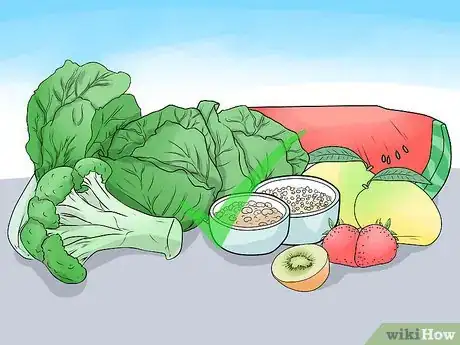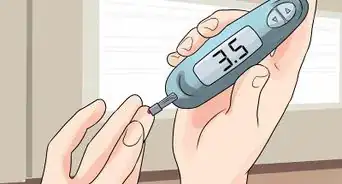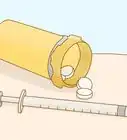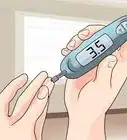This article was medically reviewed by Mark Ziats, MD, PhD. Dr. Mark Ziats is an Internal Medicine Physician, Scientist, Entrepreneur, and the Medical Director of xBiotech. With over five years of experience, he specializes in biotechnology, genomics, and medical devices. He earned a Doctor of Medicine degree from Baylor College of Medicine, a Ph.D. in Genetics from the University of Cambridge, and a BS in Biochemistry and Chemistry from Clemson University. He also completed the INNoVATE Program in Biotechnology Entrepreneurship at The Johns Hopkins University - Carey Business School. Dr. Ziats is board certified by the American Board of Internal Medicine.
There are 15 references cited in this article, which can be found at the bottom of the page.
wikiHow marks an article as reader-approved once it receives enough positive feedback. In this case, 95% of readers who voted found the article helpful, earning it our reader-approved status.
This article has been viewed 39,423 times.
Prediabetes is a condition considered an early form of diabetes. Individuals with prediabetes have higher than normal levels of blood glucose, but not high enough to be diagnosed as diabetics.[1] Individuals with prediabetes (also known as insulin resistance) have a very high risk of developing Type 2 diabetes. If you think you may have prediabetes, you may be able to reverse the symptoms and become healthier.
Steps
Controlling Prediabetes With Diet
-
1Limit processed and prepared foods. Keep your food as close to its original or natural form as possible. This means that you should try to limit any processed or prepared foods. Cook from scratch as much as possible.[2]
- Processed foods sometimes contain huge amounts of sugars. For example, one teaspoon of sugar is equal to about four grams. One six ounce serving of low-fat yogurt has 28 grams, which is seven teaspoons of sugar in one serving of yogurt. One tablespoon of pure honey has only 16 grams.
-
2Include complex carbohydrates. Whenever you eat carbohydrates, make sure they are complex, and not simple, carbohydrates. While both simple and complex carbohydrates are broken down into glucose in the body, it takes the body longer to break down the complex carbohydrates. Complex carbohydrates are found in whole, unprocessed foods such as whole grains, peas, lentils, beans, and vegetables.[3] [4] [5] Go for brown rice, whole grain pasta, and whole grain breads if you want to eat those items.
- Avoid simple carbohydrates. A good rule of thumb is no white foods. No white bread, white pasta, white potatoes (like french fries), or white rice. Also avoid candies, cookies, cakes, bagels, donuts, and other confections. Many breakfast cereals also have simple carbohydrates.[6]
- Eat most of your complex carbohydrates at breakfast or lunch. Cut down on the portion sizes of complex carbs for meals later in the day to prevent your blood glucose levels from getting too high at night.
Advertisement -
3Reduce your processed sugar intake. Processed and refined sugars are simple carbs that should be avoided. Make sure to read the labels of all foods, not just sweets. Sugars appear in many common items, like pasta sauce, ketchup, salad dressings, and breads.
- Be especially careful with beverages. A significant amount of people’s daily sugar intake is from drinks. Stay away from fruit juice, Koolaid, fruit drinks, vitamin waters, and sports drinks. Instead, drink unsweetened tea, water, and coffee — but skip the sugar-loaded coffees from chains.[7]
- Drink diet soda instead of regular soda. Regular soda has an enormous amount of sugar in it and is one of the worst things you can drink. Though, be aware, diet soda has its drawbacks, too.
- Although reading labels can be useful to determine the amount of sugars in a food, manufacturers are not required to list added sugars. You can avoid any added sugars by sticking to unprocessed foods.
- Simple carbohydrates are often found in added sugars, like glucose, sucrose (table sugar), and fructose, most often added as high fructose corn syrup.[8]
-
4Increase your fiber. Increasing the fiber in your diet helps make you feel fuller and helps digestion. It also helps your body remove fats and other metabolites in your stool. Fiber is found in fruits and vegetables, including leafy green vegetables, along with beans and legumes.[9]
-
5Increase fruits and vegetables. You should increase the fruits and vegetables you eat every day. Fruits and vegetables contain essential vitamins, minerals, and nutrients. Go for vegetables that are less starchy, like broccoli, leafy greens, carrots, and green beans. Eat at least three servings a day.[10]
- Eat fruit in moderation. The sugars in fruit are combined with the fiber, which means that the absorption of sugars from the fruit are slowed down. But you still want to reduce your sugar intake. Eat one to three servings each day.
-
6Eat white meats. Limit the red meats in your diet, like beef, steak, lamb, pork, and deli meats. Instead, increase the amounts of fish and skinless poultry you eat. Look for wild-caught fish, such as salmon, cod, haddock, and tuna.[11] Reducing red meats is not directly connected to your blood sugar level; however, type 2 diabetes is often part of a larger set of conditions known as metabolic syndrome. Reducing cholesterol levels, blood pressure, and losing weight (which may be helped by cutting out red meat) can decrease your risk of metabolic syndrome and, therefore, your risk of diabetes.
- These fish are good sources of omega-3 fatty acids that are essential for your health and are anti-inflammatory.
-
7Eat healthy fats. Good fats include polyunsaturated fat and some saturated fats (dairy fat) and are found in nut oils, nuts, and seeds can actually protect against metabolic T2D. Bad fats include trans fats, and are found in margarine, prepackaged baked goods, fried food.[12]
- Eat olive oil, coconut oil, and avocado oils. Avocados, walnuts, macadamia nuts, chia seeds, flax seeds, and most other seeds and nuts are good sources for healthy fats.
- Beware of anything containing partially hydrogenated oil.
-
8Choose lower calorie foods. Instead of eating high-calorie foods, go for lower calorie options. Snack smarter by putting away high-calorie chips, crackers, and junk food. Instead, eat wheat crackers, natural peanut butter, or fruits and veggies.[13]
-
9Cook with herbs. There are a large number of herbs that may help control blood sugar levels, though more research is necessary. Add these herbs to taste whenever you want. These herbs may help you get over some of those sugar cravings as well.[14] Good herbs are:
- Cinnamon
- Fenugreek
- Ginger
- Garlic and onions
- Basil
- Bitter melon
-
10Control your portion sizes. Overeating can lead to obesity, which can lead to your body being insulin resistant, and eventually to T2D. Control how much you eat at meals. Use a smaller plate, like a salad plate. Refrain from eating seconds. Eat slowly and savor each bite.[15]
- Drink a glass of water half an hour before your meals.
- Try not to eat at all-you-can-eat buffets.
- Think about what your plate looks like. Half the plate should be fruits and vegetables. One fourth should be a complex carb, like brown rice or a sweet potato. The remaining fourth needs to be a lean meat, like baked chicken or grilled fish.
Reversing Prediabetes Through Other Lifestyle Changes
-
1Drink plenty of water. Increase the amount of water you drink. Try to get about six to eight eight ounce glasses of water a day. Water not only helps with digestion and flushing out toxins, it has no sugar. Replacing sugary drinks with water can make a significant difference.[16]
- Some people say drinking water helps them feel full and not as hungry.
-
2Lose extra weight. Weight loss can significantly lower your chances of getting diabetes. You don’t even have to lose a lot. Losing five to 10 percent of your body weight can lower your chances of diabetes over 50%.[17] [18]
- If you weigh 300 pounds, losing 10 percent of your body weight is only 30 pounds, and five percent is only 15. If you weigh 250, 10 percent is 25 pounds, and five percent is 13 pounds. These totals are not so large that they are unattainable. You can safely reach these goals.
- Make sure to lose weight healthily. Extreme weight loss measures, like unhealthy diets or not eating, can negatively affect your blood sugar levels. One to two pounds a week (which can be achieved by cutting out 500 calories a day) is a safe pace for weight loss.
- If you make the diet changes to reverse prediabetes, you should start to see weight loss. Eat a healthier diet, which means including more fruits and vegetables, complex carbs, and lean proteins. You should limit sugar, refined carbs, fried foods, processed foods, and other junk foods.
- Another healthy way to lose weight is to increase your physical activity. These can be small changes, like taking a walk each day, increasing the duration of your walk, or the number of days you walk. You can also start taking stairs, dance around your house, do a workout tape, swim, hike, or anything else that gets your moving and your heart rate up.
- Talk to your doctor about a diet and exercise plan if you are unsure how to start.
-
3Increase your daily activity. Increasing your physical activity moderately can help reverse prediabetes. You don’t have begin a strenuous routine. Simple changes and small increases in activity level can help. Try for 30 minutes of activity, a mixed activity if you want, at least five days a week.[19] [20] Start slowly so these changes become permanent lifestyle choices.
- Find an activity that you can commit to. Walking, climbing more stairs, doing more outdoor activities, hiking, gardening, aerobics, using an elliptical, rowing machine or stationary bicycle and stretching are all examples of moderate physical activity.
- Park your car further from the office, or get off the elevator two to three floors early and walk the rest of the way. The next week, park further and get off the elevator four to five floors earlier.
- Start with 10 minutes of activity a day and begin adding on minutes every week. You may be quite amazed at how quickly the time passes. Don’t forget to warm up, especially if you are trying to jump right into it.
- Consider joining a gym and getting a personal trainer. Make sure you know and understand any physical conditions that may limit your activity and find a trainer to help you get around those conditions safely.
-
4Find a support group. Making lifestyle changes, staying on track, and losing weight is difficult. Find people who will cheer you on, help keep you accountable, and offer support. This can be family or friends, or a diabetes support group.[21]
Understanding Prediabetes
-
1See your doctor often. If you have been diagnosed with prediabetes, you should let your physician know how you have changed your diet to improve blood sugar control, lose weight, and reverse prediabetes. Get regular checkups, every three to six months, including blood and urine tests as advised by your physician.[22]
- Keep track of your labs so you can see how well you are doing and celebrate your progress.
-
2Know who is at risk. Certain factors make people more at risk for prediabetes. People at risk for prediabetes are:[23] [24]
- People who are overweight or obese.
- People who exercise infrequently.
- People who are older than 45 years old.
- People with a family history of diabetes.
- Women with a history of gestational diabetes.
- African Americans, Mexican Americans, American Indians, Native Hawaiians, Pacific Islanders and Asian Americans
-
3Know the symptoms of prediabetes. Often, there are no symptoms of prediabetes. If you see a physician regularly and have your blood tested, your physician may notice that your blood sugars tend to be on the high side, but not high enough to diagnose T2D. You may display symptoms of diabetes or have diabetes related problems with prediabetes.[25]
- Fasting blood sugar levels between 100 to 125 mg/dL are suggestive of prediabetes.
- Your doctor may also measure Hemoglobin A1C to test for prediabetes. This is a three-month average of blood sugar levels. Normal is under 5.7. A diagnosis of diabetes mellitus is made if two consecutive A1C tests are over 6.5. Patients with A1C between 5.7 and 6.5 have prediabetes.
- One early sign that is a risk for T2D and that may signal prediabetes is a skin condition known as acanthosis nigricans. In acanthosis nigrican, the skin around the neck, armpits, elbows, knees, and knuckles get darker.
- You may also experience increased hunger, thirst, fatigue, weight gain, or increased urination.
-
4Know that prediabetes can be reversed. Just because you have prediabetes does not mean you will have type 2 diabetes. Prediabetes can be reversed by losing weight. You can also reverse the effect by changing the way you eat and exercise.
- It is believed that almost all type 2 diabetes could be prevented with diet and nutrition.[26]
References
- ↑ http://www.diabetes.org/diabetes-basics/diagnosis/
- ↑ https://pubmed.ncbi.nlm.nih.gov/30218282/
- ↑ https://www.nlm.nih.gov/medlineplus/ency/imagepages/19529.htm
- ↑ http://www.ncbi.nlm.nih.gov/pubmed/26376619
- ↑ Polonsky, KS., The Past 200 Years in Diabetes. New England J of Medicine, (2012) 367:1332-1340.
- ↑ http://www.hsph.harvard.edu/nutritionsource/preventing-diabetes-full-story/#Simple_steps
- ↑ http://www.hsph.harvard.edu/nutritionsource/preventing-diabetes-full-story/#Simple_steps
- ↑ https://www.diabetes.co.uk/nutrition/simple-carbs-vs-complex-carbs.html
- ↑ https://www.mayoclinic.org/healthy-lifestyle/nutrition-and-healthy-eating/in-depth/fiber/art-20043983
- ↑ https://www.cdc.gov/diabetes/prevent-type-2/guide-prevent-type2-diabetes.html
- ↑ http://www.hsph.harvard.edu/nutritionsource/preventing-diabetes-full-story/#Simple_steps
- ↑ http://www.hsph.harvard.edu/nutritionsource/preventing-diabetes-full-story/#Simple_steps
- ↑ https://www.niddk.nih.gov/health-information/diabetes/overview/preventing-type-2-diabetes
- ↑ http://www.diabetes.co.uk/Diabetes-herbal.html
- ↑ http://www.uhc.com/health-and-wellness/health-topics/diabetes/preventing-pre-diabetes
- ↑ http://www.hsph.harvard.edu/nutritionsource/diabetes-full-story/
- ↑ http://www.diabetes.org/diabetes-basics/diagnosis/
- ↑ http://www.hsph.harvard.edu/nutritionsource/preventing-diabetes-full-story/#Simple_steps
- ↑ http://www.diabetes.org/diabetes-basics/diagnosis/
- ↑ http://www.hsph.harvard.edu/nutritionsource/preventing-diabetes-full-story/#Simple_steps
- ↑ https://www.cdc.gov/diabetes/prevention/lcp-details.html
- ↑ https://www.cdc.gov/diabetes/managing/care-schedule.html
- ↑ Polonsky, KS., The Past 200 Years in Diabetes. New England J of Medicine, (2012) 367:1332-1340.
- ↑ http://www.uhc.com/health-and-wellness/health-topics/diabetes/preventing-pre-diabetes
- ↑ http://www.diabetes.org/diabetes-basics/diagnosis/
- ↑ Polonsky, KS., The Past 200 Years in Diabetes. New England J of Medicine, (2012) 367:1332-1340.












































































Medical Disclaimer
The content of this article is not intended to be a substitute for professional medical advice, examination, diagnosis, or treatment. You should always contact your doctor or other qualified healthcare professional before starting, changing, or stopping any kind of health treatment.
Read More...